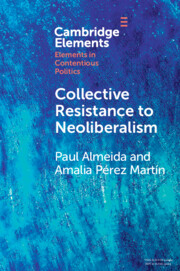Element contents
Collective Resistance to Neoliberalism
Published online by Cambridge University Press: 15 August 2022
Summary
- Type
- Element
- Information
- Series: Elements in Contentious PoliticsOnline ISBN: 9781108980005Publisher: Cambridge University PressPrint publication: 08 September 2022
References
- 15
- Cited by

